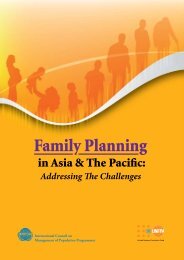CHAPTER 1INTRODUCTIONThe inter-linkages <strong>between</strong> population dynamics - size, growth, age-sex composition, and distribution - anddevelopment, particularly economic growth and poverty reduction, need for public services, gender, sexualand reproductive health and rights (SRHR) and HIV/AIDS, have been a subject of considerable literature.However, the nature and quantum of linkage effects, although significant, remain difficult to quantify. Theyalso possibly depend upon the prevailing context.It is therefore, essential that development planning takes into account these inter-linkages and both respondto population dynamics as well as directly and indirectly influence them. These three country case studiescovering Bangladesh, <strong>In</strong>dia and Malaysia, is prepared to understand how plans of various development sectorstake into account these inter-linkages and identify some promising practices to address these inter-linkages.Documentation ProcessThe three country case studies 1 were prepared through review of policies and plans, and relevant secondaryliterature. Given the vast amount of literature available, the review is fractional rather than comprehensive.A checklist developed by ICOMP was used to assess how well the inter-linkages <strong>between</strong> population dynamicsand gender equality, sexual and reproductive health (SRH) and HIV/AIDS were incorporated into a country’sdevelopment plan. Whether population dynamics, gender equality, HIV/AIDS and SRH were taken into accountwhen planning for improving the quality of life, poverty reduction and sustainable development, and how wellit was taken into account were also gauged.For Bangladesh, based on the most recent country development plan - the National Strategy for AcceleratedPoverty Reduction, 2009-2011, which is the PRSP 2 - an assessment was made as to how well populationdynamics and gender equality, SRH and HIV/AIDS were incorporated in the development planning process, interms of indicators and programmes/interventions. For <strong>In</strong>dia and Malaysia, the Eleventh Five-year Plan(2007-2012) and the Ninth Malaysia Plan (2006-2010) were used, respectively.<strong>In</strong> addition, interviews were conducted with several key persons in the field. <strong>In</strong> Bangladesh, interviews withkey personnel from the Planning Commission of Bangladesh, Ministry of Health and Family Welfare (MOHFW),Department of Women’s Affairs, and UNFPA Bangladesh were carried out. <strong>In</strong> <strong>In</strong>dia, personnel from thePlanning Commission, Government of <strong>In</strong>dia were interviewed. <strong>In</strong> Malaysia, interviews were carried out withpersonnel from various sections of the Economic Planning Unit (EPU), Prime Minister’s Department of Malaysia.<strong>In</strong> Chapter 2, we take a brief look at the population and development dynamics; relevant policies related tothe inter-linkages <strong>between</strong> population dynamics and development; and addressing the inter-linkages <strong>between</strong>population dynamics and development in the country development plan in each of the three countries. Thepromising practices and challenges are presented in Chapters 3 and 4, respectively. Chapter 5 concludeswith a discussion on recommendations for strengthening the inter-linkages <strong>between</strong> population dynamics anddevelopment.1The case study on <strong>In</strong>dia was developed by Jay Satia, and the case studies on Bangladesh and Malaysia were developed by Hwei MianLim for ICOMP with support from the Asia and the Pacific Regional Office of the United Nations Population Fund (APRO, UNFPA).1
CHAPTER 2CASE STUDIESThree countries are featured in the case studies, namely, Bangladesh, <strong>In</strong>dia and Malaysia. For each country,we will take a brief look at the population and development dynamics; relevant policies related to interlinkages<strong>between</strong> population dynamics and development; and the extent to which the country developmentplan addresses inter-linkages <strong>between</strong> population dynamics and development.BangladeshBrief Look at Population and Development DynamicsBangladesh’s population was about 129 million in 2002, an increase of 25 million from about 104 million in1990. It is projected that its population will be about 172 million in 2020. <strong>In</strong> general, Bangladesh has ayoung population (43% of the population is below age 15).The population annual growth rate has declined slowly from 2.33% in 1981 to 1.54% in 2001 and 1.48%in 2007. The crude birth and death rates, in 1998, were 19.9 and 4.8 per 1,000 population, respectively.Contraceptive prevalence rate (CPR) is 54% in 1999/2000. The total fertility rate (TFR) has declinedmarkedly from 6.6 in mid 1970s to 3.3 in the 1990s. However, since then it has plateaued due to exceptionallyhigh adolescent fertility. As a result, the target to achieve net replacement level fertility (net reproductionrate (NRR)=1 or TFR=2.1) by 2005 has been deferred to 2010.Causes of concern are early marriage and early pregnancy. About half of the teenage girls aged 15-19 aremarried and about 57% of them become mothers before age 19. This resulted in the high adolescent fertilityrate and maternal mortality ratio (MMR). The latter is 30-50% higher than the national rate. If this trendcontinues, the target for population stabilisation by 2035 will not be achieved.Selected key socio-economic and development indicators (%)Percentage of population, urban, 2005 25.1Literacy rate, male ≥ 15 years old 1 61.0Literacy rate, female ≥ 15 years old 1 43.0Literacy rate, total, 2006 2 54.0Secondary school enrolment, school age male population 49.0Secondary school enrolment, school age female population 54.0Unemployment rate, 2005-2006 3 4.2Population living below poverty line, rural, 2000 4 53.0Population living below poverty line, urban, 2000 4 36.6Population living below poverty line, total, 2000 4 49.8Sources: UNFPA Worldwide Country Profile: Bangladesh. http://www.unfpa.org/worldwide/indicator.do?filter=get<strong>In</strong>dicatorValues;1GOB and UN Country Team in Bangladesh. 2005. MDGs. Bangladesh Progress Report, 2005; 2 MOHFW, GOB. 2008. NationalHealth Policy (August 2008 version); 3, 4 GOB and UN Country Team in Bangladesh. 2005. MDGs. Bangladesh Progress Report,2005.2














